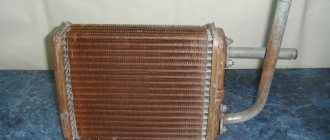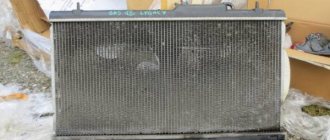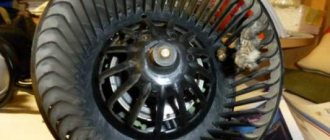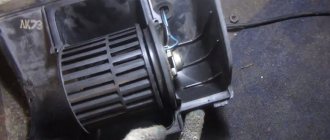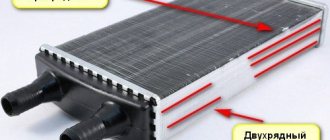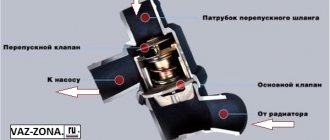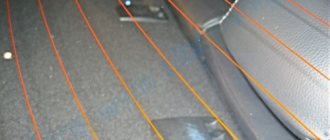Leak location
The first step is to determine the location of the fluid leak. To do this you need:
- pour cooling liquid into the expansion tank above the minimum level;
- start the engine and warm up to operating temperature;
- park on a level surface;
- After the engine has cooled, look under the car and find the leak.
If the leak comes from the radiator, then it is necessary to carry out the manipulations suggested below.
The radiator is leaking: what to do, how to find the leak and how to fix it
The cooling radiator is the main element of the engine cooling system. The operation of a cooling radiator is the active transfer of heat into the atmosphere from the heated coolant. This process is important for efficient engine operation, because The coolant, before giving off heat in the radiator, takes this heat from the heated components and parts of the engine. This was originally intended by the designers, but life makes its own adjustments to the operation of the car on the road.
A situation when the arrow on the dashboard begins to treacherously creep up, and, unfortunately, this arrow is not an indicator of the fuel level, but an indicator of the coolant temperature, modestly indicating that the car is starting to overheat. Steam is pouring out from under the hood, and a liquid stain of coolant is slowly but surely spreading on the asphalt. The radiator is leaking, what should I do?
Causes of radiator leaks in the car cooling system
Before you do anything, you need to figure out what led to this result. This may be external damage as a result of stones, or the plastic elements of the radiator may crack as a result of an impact in a minor accident. Such minor damage, as a rule, cannot be immediately identified, and problems arise from them over time. In the meantime, the driver continues to operate the car, gradually, drop by drop, losing coolant from the system.
What is the danger of antifreeze leaking from a car cooling system?
As the coolant level drops, the risk of engine overheating increases, which in turn can lead to the following problems:
Deformation of the plane of the cylinder block or cylinder head
Cylinder head gasket deformation
· Changes in the configuration of the cooling system and associated failure of system components
All of the above cases will lead to expensive repairs.
What to do if the cooling radiator is leaking
The first rule in this case is to monitor the coolant level.
In fact, periodically checking the vehicle's technical fluids before a trip is a good rule; this will help to promptly notice an emerging problem and eliminate it. Even if the cooling radiator leak is small, do not underestimate the scale of the current situation. Over time, radiator leakage will increase, and this point can be overlooked. The driver will not like the result.
Therefore, if such a situation occurs, it is necessary to have a supply of coolant or distilled water. Yes, if the loss of coolant is small, then for the first time you can use distilled water, but you need to take into account that the more distilled water gets into the system, the more we increase the freezing point of the coolant. Therefore, if it’s winter outside, you shouldn’t get carried away with distilled water, but add coolant.
What to do in case of major damage and leakage of the cooling system
If there is serious damage to the engine cooling system, repairs are inevitable; operating the vehicle in this case is extremely undesirable. And in order not to end up with engine repairs, you should move the car to a technical center using a tow truck, or, in extreme cases, on a cable.
How to seal plastic parts of a cooling system with a leak
If the design of the radiator allows, then you can use a heat-resistant sealant-adhesive, better known as cold welding. In some cases, you will need to remove the radiator from the car.
Cold welding is a special two-component sealant that may contain metal shavings. Such sealants allow you to quickly restore plastic or metal parts.
The gluing process itself is not complicated:
· Before applying the sealant, the surface must be prepared, cleaned and degreased.
· Prepare the sealant for use by mixing the two components. The components must be thoroughly mixed to obtain a homogeneous mass.
Folk method
If it is not possible to eliminate the leak using special means, then you can take powdered mustard or ground pepper and carry out the following manipulations.
- Pour powder or pepper into a container in the proportion: 1 g per 1 liter of cooling system volume.
- Pour 200-300 ml of antifreeze into the container.
- Bring the engine to operating temperature and turn it off.
- Pour the prepared mixture into the radiator.
- Start the engine for 15-20 minutes.
This mixture will seal cracks in the radiator, which will allow you to get to the place where they can carry out repairs.
conclusions
The reasons and methods for eliminating the effect of antifreeze leaks on the interior mats in the VAZ-2114 are considered. So, when a motorist discovers such a problem, he must eliminate it immediately, because the consequences can be very diverse. If the car owner is unable to solve the problem, it is recommended to contact a car service center.
I had no idea that antifreeze was so harmful to health. Personally, I think that the antifreeze in these VAZs is the biggest problem and the main drawback. It generally flows for different reasons and from different places. This cooling system with antifreeze was a very bad idea. Use spring clamps - I installed these myself and am very pleased.
In fact, the most unpleasant consequences are engine overheating. And not the smell in the cabin. In any case, it is better to treat the malfunction at a car service center. In winter, this is extremely inconvenient to do if you don’t have a garage.
Repair sealants
Sealant can be purchased in powder, tablet or liquid form.
Also, the sealant can be highly specialized or universal. The first will help carry out emergency repairs of a copper or aluminum radiator. The second can eliminate damage to the entire cooling system, regardless of the type of radiator.
We must not forget that the use of sealants is a temporary measure.
When applying sealant, the following steps must be taken.
- Warm up the engine to operating temperature.
- Pour sealant into the radiator.
- Close the radiator and start the engine.
- Let the car run for 15-20 minutes and add antifreeze.
Sealants, according to manufacturers, are compatible with any type of coolant. That is why you can safely use sealant as a temporary means of eliminating leaks.
How to remove the stove on a VAZ 2114
Let's start with the fact that on a VAZ 2114, replacing the heater radiator is fraught with some difficulties. In other words, in order for the replacement of the VAZ 2114 stove to be carried out efficiently, it is necessary to separately take into account certain subtleties and nuances.
To begin, you need to prepare:
- Screwdriver Set,
- spanners;
- coolant drain container
- new radiator, faucet, etc.
Before replacing the VAZ 2114 heater radiator, you need to drain the coolant (if the coolant has not been changed for a long time, then it is better to combine the heater repair with replacing the antifreeze or antifreeze).
- First, you will need to unscrew the self-tapping screw located under the plastic plug in the cabin, unscrew the fastenings of the instrument panel, and also loosen the fasteners of the instrument panel. The shield does not need to be removed.
- Next, unscrew the lower fasteners and remove the steering column cover. Then the connector for the cigarette lighter is removed, the radio is dismantled, etc.
- When removing connectors and plugs, it is better to sign or mark them so that there are no problems during reassembly.
- When all the elements are removed, access to the plastic console will open. The symmetrical screws on both sides should be unscrewed.
By the way, replacing the VAZ 2115 stove is carried out in a similar way. The main thing is to get to the heater radiator. Having gained access, through the gap you can remove the radiator, which is held in place by clamps. By removing the specified clamps, the remaining coolant is drained. Now you can replace the radiator with a new one, installing it in place of the old one and securing it securely.
Soldering copper and brass radiator
To eliminate leaks from such radiators, you must have a gas torch, solder paste and tin solder.
You must adhere to the following procedure.
- Clean the damaged area with sandpaper and a file.
- Heat the damaged area with a gas burner.
- Apply solder paste or acid.
- Apply solder to the crack and heat it with a torch. Wait until the solder fills the damaged area.
- Remove excess tin after it dries.
After the work has been done, the radiator must be closed, placed in a bath of water and checked for bubbles. If they are absent, the radiator can be considered serviceable.
Major radiator damage
If the crack or damage in the radiator is large, then solving this problem is not easy. It is especially difficult to seal a leak if it is caused by internal corrosion. One of the main repair methods in similar cases is soldering, which requires removing the radiator. At the same time, you need to know that soldering must be done with experience, and in the absence of such knowledge, it is better not to start such work with your own hands, since you can completely render the radiator unusable, which will require its replacement.
Internal radiator repair with a chemical agent
Most experts do not recommend resorting to this method. However, when you need to drive urgently, and antifreeze is flowing on the asphalt, you don’t really have much of a choice.
By the way, the method will only work with minor cracks. If there is a stone sticking out of the radiator, then all work will have to be cancelled.
Considering that all chemicals work according to the principle of a long-proven old-fashioned method, it will be easier to turn to the original source.
Related article: Why oil leaks from the engine, how to find and fix the leak
Back in Soviet times, when the Chinese chemical industry did not pay attention to the problems of car enthusiasts, mustard powder came to the rescue. It is poured into the neck (with the engine running). Since the fluid in the radiator is hot, it swells and fills the crack.
If mustard does not inspire confidence, you can buy a product special for this purpose at a car dealership.
They are called differently: powder reducer, radiator sealant, etc. But, as already mentioned, it is better to use other methods, because it is impossible to predict exactly how and where the powder will settle, and it can easily clog several tubes.
Application of cold welding
In “field” conditions, it can be useful if the damage is clearly visible and does not require dismantling the radiator. If the repair is carried out “at home”, then it is better to remove the product. For this:
- drain the coolant from the cooled engine into a previously prepared container through special holes in the cylinder block and the lower part of the radiator (you can loosen the pipe clamp);
- disconnect the electrical connectors from the temperature and fan switch sensors;
- loosen the clamps and remove the hoses and pipes suitable for the radiator;
- unscrew the screws securing the product and pull it out (in some models, together with the fan).
“Cold” welding is a product consisting of adhesive-sealant and metal powder. The composition can be ready for use or sold in the form of separate components that must be mixed before use to obtain a homogeneous mass. Process of using the product:
- clean the area around the defective hole or crack with sandpaper;
- degrease the problem area with gasoline or acetone;
- mix the composition if it is made of separate components or knead it with your hands according to the instructions (then you can paint this place);
- wait until it sets;
- Complete hardening occurs depending on the brand of “cold” welding and takes 1-24 hours.
Next, install the radiator in place, at the same time cleaning it from dust and insects that clog the honeycombs from the outside. The main advantage when using such compositions is that they have the same coefficient of thermal expansion as metal. That is, the patch may not allow coolant to pass through for several years.
On what principle does a heater radiator work?
Coolant circulates through small tubes in the heater core, entering through one hose and leaving through another. The radiator, by dissipating the heat of the fluid passing through it, provides heating to the cabin, preventing passengers from freezing on a cold winter morning. In addition, the heater radiator is responsible for the operation of the glass heating system. It is connected to the air conditioning system, organized according to almost the same principle.
Removing a non-working tube and its elements
We need a hot rod, we need to put it in the tube and wait, if the temperature of the rod is sufficient, the solder will become soft. Next, the tube with the rod is removed from the tank, and a new one is put in its place and sealed.
Argon-arc electric welding is performed using filler material; most often, specialized aluminum welding wire is used. When using this type of welding, you need to know many nuances, for example: aluminum oxide deposits prevent good weldability. To avoid this, argon is supplied to the welding site, the task of which is to reliably protect the metal from oxidation, as a result of which the weld becomes without pores and cavities. Also, after heating to the desired temperature, all substances turn from solid to liquid. During such welding, the temperature rises above 400°C; at this temperature, aluminum becomes less durable and can crumble even with a slight impact.
Video: Replacing and repairing the heater radiator VAZ 2110, 2111, 2112
A temporary solution to the problem of the current cooling radiator may be the use of chemicals.
Car radiator leak - elimination + VIDEO
As you know from a physics course, heat is always generated when a motor is running. The car engine performs a huge amount of work and at the same time gets very hot. Even in the very first cars, an engine cooling system was used, without which not a single car would be able to function normally.
There are several types of engine cooling systems:
The vast majority of modern cars use a liquid system, in which cooling is achieved using coolant - antifreeze, antifreeze or plain water. The main element of the cooling system is the radiator, which acts as a heat exchanger.
The radiator has a fairly simple design:
- upper tank - heated liquid enters it;
- core - consists of many thin plates and vertical tubes;
- lower tank - already cooled liquid flows into it.
Cooling occurs due to the fact that the liquid flows into tubes, of which there are a lot. And it is much easier to cool small volumes of a substance than large volumes. An important role in cooling is played by the fan impeller, which, when rotating, creates air flows for faster cooling.
It is clear that if the cooling system stops functioning normally, the engine will very quickly overheat and fail.
Over time, cracks may form in the radiator tubes. The reasons for their appearance can be very different:
- mechanical damage;
- corrosion processes - incorrectly selected antifreeze or antifreeze;
- cracked seams at the joints of the tubes - seams crack due to old age, as well as due to increased pressure inside the radiator.
It is also important to pay attention to the fact that a small leak of antifreeze can only be detected when the engine is running. Even if the leak is very small - a few drops per minute - you will still notice that the liquid level in the tank is decreasing. We have already written on our car portal Vodi.su that good antifreeze or antifreeze is quite expensive, and there is no desire to constantly add it to the radiator. Therefore, measures have to be taken to eliminate the increased consumption of antifreeze.
What is a heater radiator?
The heater radiator belongs to the cooling system. It looks like a mini version of the main engine cooling radiator and is essentially a small unit that consists of small tubes installed in parallel, connected by a series of cross plates (or fins) designed to dissipate heat. This radiator ensures the operation of the interior heater and the vehicle's glass heating system.
Heater core replacement procedure
- Disconnect the battery.
- Remove the steering wheel.
- Remove all exterior panels and housings for items such as the fuse box, speakers, and the compartment trim in front of the front passenger seat.
- Remove the glove box, radio, speakers and other accessories.
- Disconnect the instruments (be especially careful where the speedometer cable passes).
- Disconnect and remove the heater and air conditioner control panel.
- Unscrew the bolts and remove the dashboard.
- Do not disconnect the air conditioner (unless absolutely necessary and if you can properly dispose of the freon). Freon should never be allowed to leak, as it negatively affects the ozone layer and is also extremely toxic, especially for people with heart disease.
- Disconnect both hoses from the heater core in the engine compartment.
- Move all air lines and other components away from the heater core housing.
- Remove the radiator housing and place it on the table. Unscrew all bolts and other fasteners to get to the radiator itself.
- Take out the old radiator and replace it with a new one!
When installing the heater core, perform the above procedure in reverse order. If any element breaks during removal, it also needs to be replaced during installation.
Source: okuzove.ru
Possibility of repairs
If the cooling radiator leaks with a small crack, you can fix the problem yourself.
But if a leak occurs at the junction of the plastic pipe and the radiator itself, then such a malfunction cannot be eliminated. Temporarily, if it is impossible to quickly purchase a new radiator, you can use sealant or epoxy glue. If there are several or one small crack through which antifreeze flows a few drops at a time, then you can quickly achieve the result with a special sealant. It should be poured into the cooling system. The components are substances that heal small cracks and create a tight seal of the radiator housing. After this, you can drive a car, since it takes some time for the sealant to take effect, after which the leak should stop.
Many car owners do not know what to do if the radiator leaks due to corrosion. In this case, sealants are useless, and the radiator can only be repaired by soldering. This is a rather complex process, and can only be done with extensive experience and special equipment. It is also difficult to repair a radiator with mechanical damage. Sometimes argon welding is used for this.
When doing independent work with a radiator for the first time, you need to prepare to redo the work. It is impossible to immediately detect all the cracks on the radiator by looking at it. This can only be seen when installing it and starting the engine. If after 30 minutes of idling no leakage appears, this means that a good result has been achieved. If a leak appears, work should be started from the very beginning.

